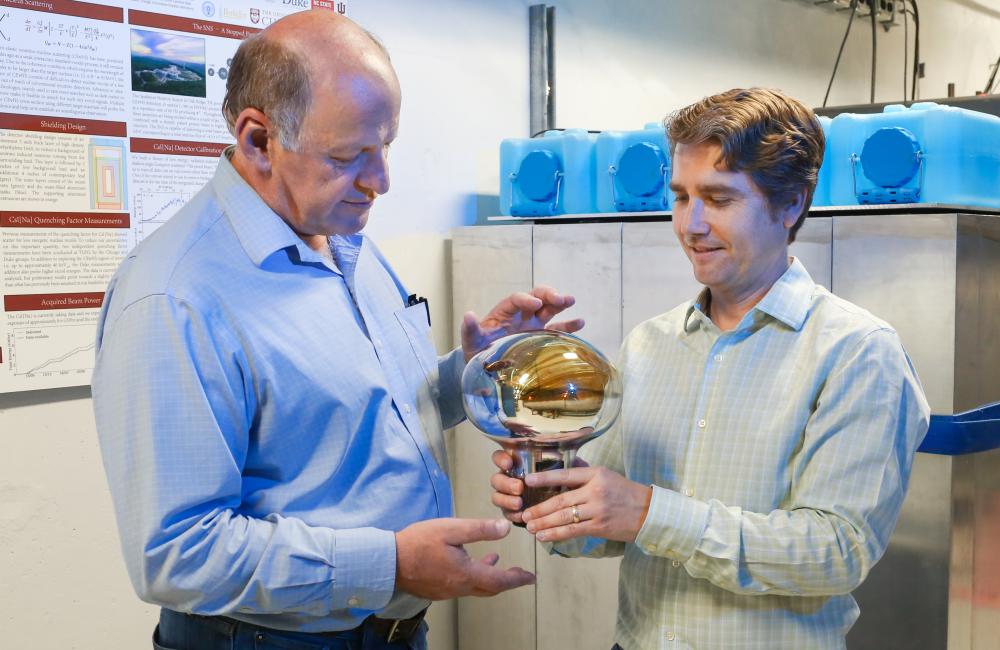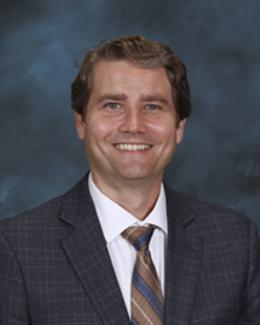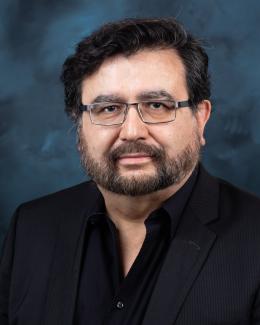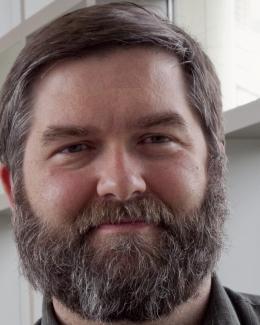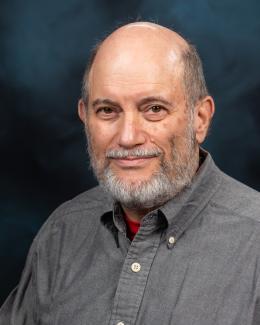From left, Professor Yuri Efremenko of the University of Tennessee–Knoxville and Jason Newby of Oak Ridge National Laboratory are among 80 participants in COHERENT, a large, collaborative, particle physics experiment to record neutrinos at the Spallation Neutron Source. Photomultiplier tubes look like giant light bulbs and are used to detect light from neutrino interactions in detectors. COHERENT’s cesium iodide detector, the first to espy neutrinos at the SNS, employs a 5-inch (13-centimeter) wide photomultiplier tube. An 8-inch (20-centimeter) wide photomultiplier (shown here) is deployed in COHERENT’s nearby liquid-argon detector. Measurements from different types of detectors are necessary for comprehensive studies of neutrinos at SNS. The scientists are standing in front of the cesium-iodide-detector shielding. Image credit: Oak Ridge National Laboratory, U.S. Dept. of Energy; photographer Genevieve Martin
OAK RIDGE, Tenn., Aug. 3, 2017—After more than a year of operation at the Department of Energy’s (DOE’s) Oak Ridge National Laboratory (ORNL), the COHERENT experiment, using the world’s smallest neutrino detector, has found a big fingerprint of the elusive, electrically neutral particles that interact only weakly with matter.
The research, performed at ORNL’s Spallation Neutron Source (SNS) and published in the journal Science, provides compelling evidence for a neutrino interaction process predicted by theorists 43 years ago, but never seen.
“The one-of-a-kind particle physics experiment at Oak Ridge National Laboratory was the first to measure coherent scattering of low-energy neutrinos off nuclei,” said ORNL physicist Jason Newby, technical coordinator and one of 11 ORNL participants in COHERENT, a collaboration of 80 researchers from 19 institutions and 4 nations.
The SNS produces neutrons for scientific research and also generates a high flux of neutrinos as a byproduct. Placing the detector at SNS, a mere 65 feet (20 meters) from the neutrino source, vastly improved the chances of interactions and allowed the researchers to decrease the detector’s weight to just 32 pounds (14.5 kilograms). In comparison, most neutrino detectors weigh thousands of tons: although they are continuously exposed to solar, terrestrial, and atmospheric neutrinos, they need to be massive because the interaction odds are more than 100 times lower than at SNS.
The scientists are the first to detect and characterize coherent elastic scattering of neutrinos off nuclei. This long-sought confirmation, predicted in the particle physics Standard Model, measures the process with enough precision to establish constraints on alternative theoretical models.
Typically, neutrinos interact with individual protons or neutrons inside a nucleus. But in “coherent” scattering, an approaching neutrino “sees” the entire weak charge of the nucleus as a whole and interacts with all of it.
“The energy of the SNS neutrinos is almost perfectly tuned for this experiment—large enough to create a detectable signal, but small enough to take advantage of the coherence condition,” Newby said. “The only smoking gun of the interaction is a small amount of energy imparted to a single nucleus.”
That signal is as tough to spot as a bowling ball’s tiny recoil after a ping-pong ball hits it.
Physicist Juan Collar of the University of Chicago led the design of the detector used at SNS, a cesium iodide scintillator crystal doped with sodium to increase the prominence of light signals from neutrino interactions. After trying more sophisticated technologies, he went back to simple inorganic scintillators. “They are arguably the most pedestrian kind of radiation detector available, having been around for a century. Sodium-doped cesium iodide merges all of the properties required to work as a small, ‘handheld’ coherent neutrino detector,” he said. “Very often, less is more.”
Success depended on finding the right combination of neutrino detector and source. “The detector was designed with SNS in mind,” Collar said. “SNS is unique not only as a neutron source, but also as a neutrino source. It will provide us with opportunities for many more exciting sorties into neutrino physics.”
Because SNS produces pulsed neutron beams, the neutrinos are also pulsed, enabling easy separation of signal from background. That aspect makes data collection cleaner than at steady-state neutrino sources such as nuclear reactors.
Three neutrino flavors were seen by COHERENT—muon neutrinos that emerged instantaneously with the neutron beam and muon antineutrinos and electron neutrinos that came a few microseconds later. “The Standard Model predicts the energy and time signatures we saw,” Newby said. “Juan [Collar] wanted to make sure that he chose a detection mechanism with the timing resolution to distinguish the prompt from delayed signals.”
The calculable fingerprint of neutrino–nucleus interactions predicted by the Standard Model and seen by COHERENT is not just interesting to theorists. In nature, it also dominates neutrino dynamics during neutron star formation and supernovae explosions.
“When a massive star collapses and then explodes, the neutrinos dump vast energy into the stellar envelope,” said physicist Kate Scholberg of Duke University, COHERENT’s spokesperson. “Understanding the process feeds into understanding of how these dramatic events occur.”
Coherent elastic scattering is also relevant for detecting the enormous neutrino burst from a supernova. “When such an event occurs in the Milky Way, neutrinos of all flavors will bump into nuclei, and sensitive dark matter detectors may observe a burst of tiny recoils,” she said.
“COHERENT’s data will help with interpretation of measurements of neutrino properties by experiments worldwide,” Scholberg concluded. “We may also be able to use coherent scattering to better understand the structure of the nucleus.”
Though the cesium-iodide detector observed coherent scattering beyond any doubt, COHERENT researchers will conduct additional measurements with at least three detector technologies to observe coherent neutrino interactions at distinct rates, another signature of the process. These detectors will further expand knowledge of basic neutrino properties, such as their intrinsic magnetism.
The team included partners from the Russian Federation (Institute for Theoretical and Experimental Physics named by A.I. Alikhanov of National Research Centre “Kurchatov Institute”; National Research Nuclear University Moscow Engineering Physics Institute), USA (Indiana University, Triangle Universities Nuclear Laboratory, Duke University, University of Tennessee–Knoxville, North Carolina Central University, Sandia National Laboratories at Livermore, University of Chicago, Lawrence Berkeley National Laboratory, New Mexico State University, Los Alamos National Laboratory, University of Washington, Oak Ridge National Laboratory, North Carolina State University, Pacific Northwest National Laboratory, University of Florida), Canada (Laurentian University), Republic of Korea (Korea Advanced Institute of Science and Technology and Institute for Basic Science).
The title of the Science paper is “Observation of Coherent Elastic Neutrino-Nucleus Scattering.”
ORNL’s Laboratory Directed Research and Development (LDRD) Program funded local siting studies and installation to establish the experiment at the SNS. The U.S. National Science Foundation, the Kavli Institute for Cosmological Physics at the University of Chicago and an endowment from the Kavli Foundation and its founder Fred Kavli supported construction of the detector.
Additional support came from the DOE Office of Science, including an award from the office’s Early Career Research Program; National Nuclear Security Administration Office of Defense, Nuclear Nonproliferation Research, and Development; LDRD programs of Lawrence Berkeley and Sandia National Laboratories; Pacific Northwest National Laboratory via the National Consortium for Measurement and Signature Intelligence Research Program and Intelligence Community Postdoctoral Research Fellowship Program; Alfred P. Sloan Foundation; Consortium for Nonproliferation Enabling Capabilities; Institute for Basic Science (Korea); National Science Foundation (USA); Russian Foundation for Basic Research; Russian Science Foundation in the framework of MEPhI Academic Excellence Project; Triangle Universities Nuclear Laboratory; University of Washington Royalty Research Fund; and resources of the Spallation Neutron Source and the Oak Ridge Leadership Computing Facility, which are DOE Office of Science User Facilities at ORNL.
UT-Battelle manages ORNL for DOE’s Office of Science. The single largest supporter of basic research in the physical sciences in the United States, the Office of Science is working to address some of the most pressing challenges of our time. For more information, please visit www.energy.gov/science. — Dawn Levy


